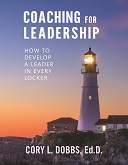Noticing a Mighty Oak in the Tiny Acorn
Cory Dobbs, Ed.D., The Academy for Sport Leadership
One thing I know is true: everyone I meet has more learning and doing capacity than I am aware of, just like the mighty oak hidden in every tiny acorn. My work with The Academy for Sport Leadership has led me to conclude that a shared leadership system is far more productive than the hierarchical model embodied in the traditional team captain model. I call the participative model, which rests on the practice of mutual learning, the Team Leadership Model.
The Team Leadership Model promotes the processes of team leadership and team building as growth opportunities. It advances the assumption that all members have the ability to inspire others, to reflect on their actions, to increase self-awareness and to leverage their relational capabilities and build positive, impactful relationships.
At the heart of the leader in every locker framework is the core belief that every student-athlete has the ability to learn and develop leadership skills. The transformational coach encourages every student-athlete to reach into their reservoir of beliefs about what is possible for them to accomplish when engaging in learning how to lead and team build. When the student-athlete does this they come to believe that more is always possible.
The coach with the ability to see more than a small capped nut will always be rewarded. More importantly, his players will grow in ways that can only happen in the right environment.
Teams that I’ve worked with that have utilized the team leadership framework—a leader in every locker—have enhanced interpersonal activity and collective effectiveness in the four domains of team sport—the physical, intellectual, emotional, and social domains. The essence of the leader in every locker model is that student-athletes learn to teach and learn in an interactive way so everyone grows individually while expanding the technical and the relational capacity of the team.
The Team Leadership model creates an environment in which members are accountable not just to the coach, but to the team as a whole. This sounds good to coaches, but very few actually practice the Team Leadership concepts. The reasons coaches balk at the idea of Team Leadership—leadership from every locker—is that, in general, they are either hooked on control or of the firm belief that leaders are simply born which leads to the conclusion that leaders are in short supply.
Some coaches will admit this, many won’t. The old way of thinking is comfortable and less time consuming. But, let me say again, my research strongly suggests the traditional captain mode is very limited. The team captain model as practiced by most coaches is a sink or swim proposition.
When you choose to make leadership and team building skills and abilities for all players a priority, not only do you increase responsibility and reliance on one another, you change how your student-athletes interact as leaders and followers.
Okay, lift the hood. Kick the tires. Compare the assumptions that undergird the two models.
|
About the Author
Dr. Cory Dobbs is a national expert on sport leadership and team building and is the founder of The Academy for Sport Leadership. A teacher, speaker, consultant, and writer, Dr. Dobbs has worked with professional, collegiate, and high school athletes and coaches teaching leadership as a part of the sports experience. He facilitates workshops, seminars, and consults with a wide-range of professional organizations and teams. Dr. Dobbs previously taught in the graduate colleges of business and education at Northern Arizona University, Sport Management and Leadership at Ohio University, and the Jerry Colangelo College of Sports Business at Grand Canyon University.
NEW RESOURCE
Coaching for Leadership: How to Develop a Leader in Every Locker. ($24.99)
The Academy for Sport Leadership
The Academy for Sport Leadership’s underlying convictions are as follows: 1) the most important lessons of leadership are learned in real-life situations, 2) team leaders develop best through active practice, structured reflection, and informative feedback, 3) learning to lead is an on-going process in which guidance from a mentor, coach, or colleague helps facilitate learning and growth, and 4) leadership lessons learned in sport should transcend the game and assist student-athletes in developing the capacity to lead in today’s changing environment.
